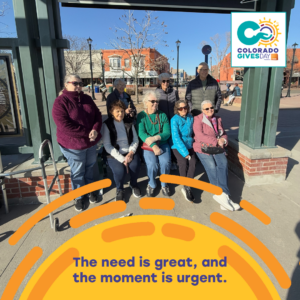- Location: Meeting by phone
- Introductions
- APAC members
- RTD
- Contractors
- Public Comment
- Concerned about RTD’s position on denying 360 people in wheelchairs unlimited access to paratransit in the last 2 years. APAC should address this.
- ACPD (Advisory Committee for People w/ Disabilities) Update by Dr. William Gross
- Had ADA Hero awards – 4 given out
- Discussion about High Blocks and who can use this space
- There has been congestion and problems surrounding use of the High Block
- This is ongoing problem and ongoing discussion
- Snow removal around RTD bus stops
- Issue because it is not owned by RTD…it’s a city and county issue
- Jaime Lewis wrote letter to mayors drawing their attention to the problem and informing them how important it is to fix.
- APAC new members
- Katie quit = Malia is replacement
- Empty seat = filled by Donna
- Merv Martin is staying on the committee
- 2 empty seats remain
- OTHER: 5 members terming out in July
- Need to recruit to fill these seats
- Several applications on file
- Could be mentioned in the Read & Ride flyer
- Need to recruit to fill these seats
- Anything from the last meeting?
- AaR – once you miss your first trip, then all future trips are cancelled.
- This is NOT true (per RTD)
- Joe – there should be a protocol as to whether or not to expect the driver to call rider if they can’t seem to find the pick up location.
- Sometimes they do, sometimes they don’t – should be one way or the other
- AaR – once you miss your first trip, then all future trips are cancelled.
- RTD
- COVID-19 Response
- Call center is restricted
- 1 day call in advance to ride
- Temporarily has stopped all subscription rides
- THEY HAVE NOT REDUCED THE LEVEL OF SERVICE
- Trips are lessening (this is a good thing)
- Trying to slow the service down to observe social distancing
- They have increased the cleaning to once a day
- Important! – Subscription trips will automatically start up again once COVID-19 danger levels go down. Riders do not have to call in to reschedule these subscription rides.
- RTD has postponed AaR eligibility process temporarily
- New applicants will be given presumptive eligibility with unrestricted access until they can be screened
- Reassessment riders will be given the same level of service they had before until they can be reassessed.
- RTD Driver Shortage Issue
- May service changes to fixed routes WILL NOT impact AaR (per RTD)
- Pre-COVID-19 – RTD was at ¼ of 1% short on drivers (nearly full employment). That is to be compared to 10% short 6 months ago.
- RTD Board Meeting tonight by phone – 855-962-1128
- Technology Update – AaR Customer Service Portal
- Being developed in house
- App will have ability to
- Cancel future trips
- Book future trips
- See real time stops and ETA
- Accessibility being checked by 3rd party company
- Late estimate is an August launch
- COVID-19 Response
- Next meeting May 12th – most likely by phone
Articles about Transportation

Yesterday our State and City representatives sent out a very innovative call to action that DRMAC thinks you might be interested in participating in. They have assembled a list of 40,000 senior citizens across Denver that we will be calling to do wellness checks on.
When needs arise throughout Denver, our City Councilors will receive them and then let our group know about how we can help. That said, we won’t know if people need help if we don’t call them!!!
The biggest need right now is to hit the phones and start calling our senior citizens throughout Denver! Here is the link to register:
Highlights included:
*Discussion and approval of Eligibility Rules and Selection Process for the RTO&T Set-Aside. The Regional Transportation Operations & Technology (RTO&T) Set-Aside funds transportation technology improvements to traffic signal systems, intelligent transportation system projects, and other technology projects associated with any travel mode. There will be a call for projects in 2020. The process begins with a pre-application workshop in April and ends with selection of projects by end of September.
*Discussion and approval of Eligibility Rules and Evaluation Process for the selection of projects to be funded through the Urban Arterial Multimodal Safety Improvements Program. Program goals are to reduce fatal and serious injury crashes on the region’s transportation system • Support a transportation system that safely accommodates all modes of travel • Improve transit access and multimodal mobility • Support the development of connected urban/employment centers and multimodal corridors • Provide safe access to opportunity and mobility for residents of all ages, incomes and abilities, including vulnerable user. Accessible crosswalk signals, complete streets improvements, improved access to bus stops are some examples of potential projects. Call for projects is in April and selections will be made toward the end of July. Nonprofits and TMAs are not eligible to apply, but may partner with a governmental organization.
*Briefing on the draft 2050 Metro Vision Regional Transportation Plan (2050 MVRTP) scenario outcome results.
*Update and information on the upcoming draft of Taking Action on Regional Vision Zero
*AMP (Advanced Mobility Partnership) Working Group update-becoming established, elected officers.
Several of those who lead emergency preparedness in the Colorado Springs area, home to Fort Carson and the Air Force Academy, point to their military backgrounds as a key reason they recently set-up MASH-like tents adjacent to hospitals in the area.
“Many of us have served in the military, and we got together and figured out what we think is the best way to separate out and screen people for COVID-19,” said David Tharp, senior director of emergency services at UCHealth in Colorado Springs.
The idea was to get ahead of the novel coronavirus and use the tents to divert those who may have the virus to a location apart from the rest of the patient population. It’s also a way to deal with the possibility of overflow patients if the virus continues to spread.
At Memorial Central, a UCHealth hospital in the Springs, patients are stopped and screened right inside the emergency entrance. Those who have respiratory issues — and appear very sick — are taken back to an isolation room in the hospital. Otherwise those coughing or having trouble breathing are diverted to the large tent outside with four exam rooms where they’re further screened. It’s up to the nurse to decide whether to test the patient. Since opening the tent to patients Tuesday, providers have been seeing about 50 people a day.
Two other UC Health facilities in the area, Memorial North and the freestanding Emergency Department in nearby Fountain, have set up tents and will open those to patients when they begin seeing increased visits. Other hospitals in the state have also erected tents or have retrofitted existing hospital space to separate potential COVID-19 patients from other patients.
Currently, many emergency rooms report seeing even fewer patients than is normal for this time of year, likely because many people decide that going to the hospital is risky. But the hospitals expect to see more patients in the next week or two.
— Andrea Dukakis (CPR Radio Staff)
Every year, we compile a grand list of things to do in Colorado. Although we put one together for 2020, right now a lot of those items are not possible to complete, due to the closures, restrictions and suggestions put in place after the COVID-19 outbreak. So instead we designed a list of things to do at home to entertain, educate and uplift you, while also supporting local businesses and creatives so that everyone can weather this storm together. Read more
It’s tough to perform or rehearse as a group when you’re practicing social distancing. But the Colorado Symphony managed to do just that — dropping an epic cut of their musicians performing Beethoven’s Ode To Joy from various locations. Read more
![DRMAClogo[1] DRMAC](https://drmac-co.org/wp-content/uploads/2019/12/DRMAC20logo1.jpg)





